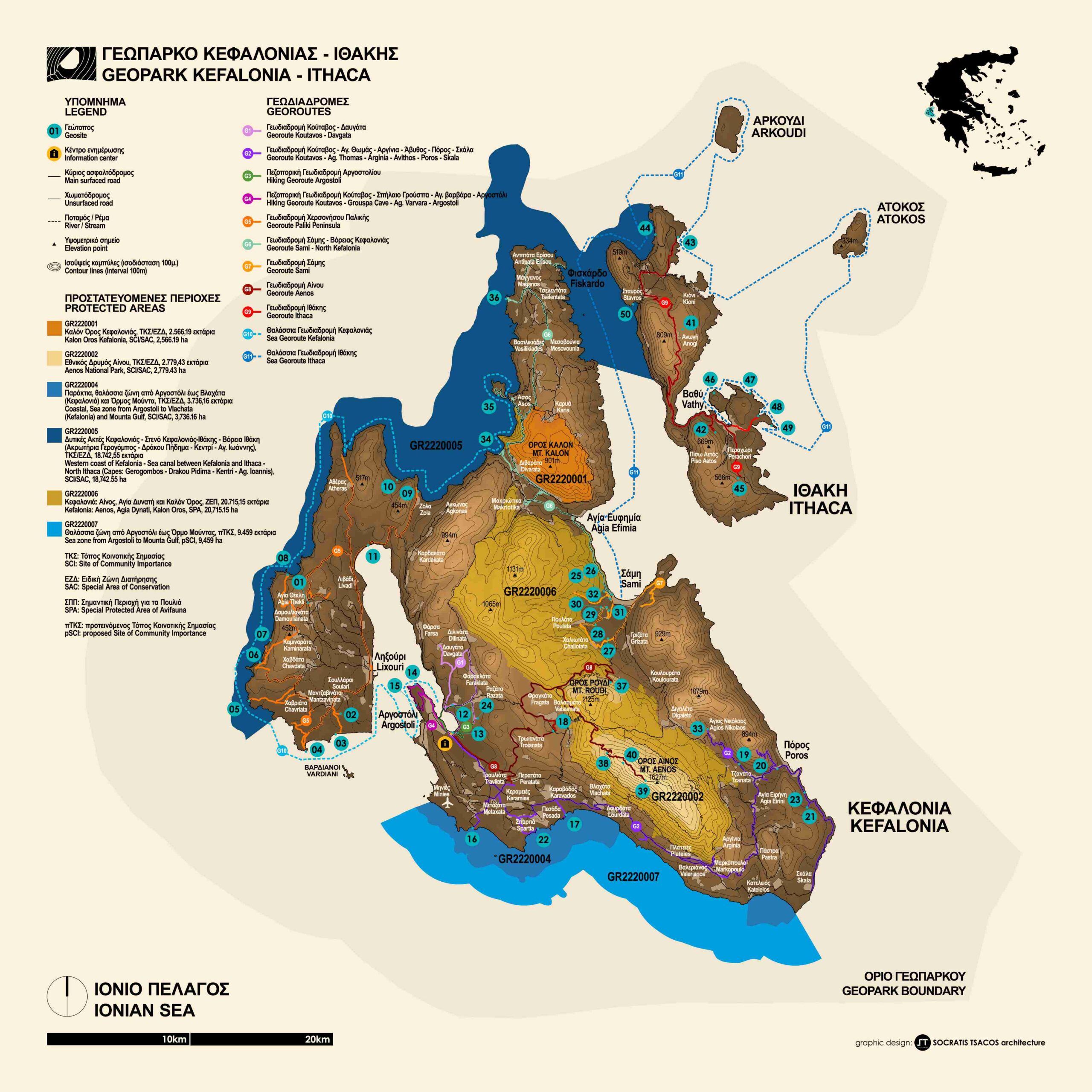Protected areas
According to Law No 4519/2018, the Management Body of Aenos National Park became the statutory body of the designated protected areas in Kefalonia and Ithaca Ionian Islands. These new areas of conservation are shown in the map below:

GR2220001 KALON OROS KEFALONIAS (SCI – SAC) 2542.9100 ha
The protected area consists of a limestone mountain called ‘Kalon Oros,’ located in the northern part of Kefalonia. It is a sparsely vegetated area hosting a Mediterranean maquis ecosystem (Quercus coccifera, Pistacia lentiscus, Arbutus unedo). The dominant type of ecotope is Sarcopoterium spinosum phryganas (Directive 92/43/ΕU) and the most important Flora species is Thymus holosericeus.
GR2220002 ETHNIKOS DRYMOS AINOU (SCI/SAC) 2903.1400 ha
This protected site constitutes Aenos National Park, with a total area of 2862 hectares, 2316 ha of which, expand to the main mountain range, (its highest peak is Megas Soros, 1628 m), and the rest extend to the neighboring Roudi mountain range (highest peak at Yioupari, 1125 m). This protected area is characterized by rocky slopes and a dominating forest of kefalonian fir (Abies cephalonica), and is recorded to be a habitat for a variety of important endemic species. Aenos forest is considered to be the representative natural habitat of Abies cephalonica Loudon, because in this mountain, the fir tree was first described and registered as a new species, in 1938. In recognition of Aenos habitat importance, in 1962, it was declared National Park, and almost simultaneously a Wild Life Refuge. It has been internationally designated member of the European Network of Biogenetic Reserves, European Ecological Network of Special Zones “Natura 2000” and European Network of Special Protection Areas for Avifauna. At lower heights, the vegetation area hosts a Mediterranean maquis ecosystem (Quercus coccifera, Pistacia lentiscus, Arbutus unedo). The types of Directive 92/43/ΕU ecotopes include tree formations of Juniperus spp., arborescent matorral with Juniperus spp., Eastern Mediterranean screes, and calcareous rocky slopes with chasmophytic vegetation. Important flora species registered comprise Abies cephalonica, Ajuga orientalis, Alkanna corcyrensis, Arenaria guicciardii, Astragalus sempervirens subsp. Cephalonicus, Campanula garganica subsp. Cephallenica, Centaurea alba subsp. Subciliaris, Cerastium candidissimum, Crocus hadriaticus, Calium peloponnesiacum, Geocaryum peloponnesiacum, Paronychia albanica subsp. Graeca, Petrorhagia fasciculata, Poa cephalonica, Scaligeria moreana, Scutellariia rubicunda subsp. Cephalonica, Silene ionica, Thymus holosericeus, Viola cephalonica.
GR2220004 PARAKTIA THALASSIA ZONI APO ARGOSTOLI EOS VLACHATA (KEFALONIA) KAI ORMOS MOUNTA (SCI/SAC) 3679.2700 ha
The area comprises coastline of southern Kefalonia, characterized by the distribution of Posidonia oceanica meadows. The registered ecotopes of Directive 92/43/ΕU include Posidonia oceanica meadows, sandbanks and reefs.
- Meadows of the marine angiosperm Posidonia oceanica are characteristic of the infralittoral zone in the Mediterranean Sea, at depths ranging from some tens of centimeters to 30-40 meters. Posidonia meadows develop both in soft and hard substrate, and can withstand large variations of temperature and water movement. Contrarily, Posidonia oceanica is sensitive to decreased water clarity and desalination, requiring salinity values 36 to 39 per 1000.
- The sandbanks are permanently covered by sea water and encountered up to 20 meters depth. They usually allow growth of Zosteretum marinae seagrass, under mild hydrodynamic conditions.
- Reefs ecotope comprises areas permanently covered by seawater, exposed areas at low tide of rocky substrate and biogenic formations deriving from the bottom of the infralittoral zone and areas of the supralittoral zone, characterized by floral and faunal populations, including crusty and coralligenous formations.
Important flora species in this protected area (although not registered to Annex II of Directive 92/43/ΕU) comprise Caulerpa cylindracea, Cystoseira amentacea, Cystoseira barbatula, Cystoseira compressa, Cystoseira crinita, Cystoseira foeniculacea, Cystoseira spinosa, Cystoseira trochanter.
GR2220005 DYTIKES AKTES KEFALONIAS – STENO KEFALONIAS ITHAKIS – VOREIA ITHAKI (AKROTIRIA GERO GKOMPOS – DRAKOU PIDIMA – KENTRI – AG. IOANNIS) (SCI/SAC) 18767.6500 ha
Important Flora species in this protected area (although not registered to Annex II of Directive 92/43/ΕU) is Posidonia oceanica, the meadows of which are the main representatives of the protected area vegetation. The types of ecotopes included in Directive 92/43/ΕU, comprise shallow inlets and bays, and submerged or partially submerged sea caves.
GR2220006 KEFALONIA: AINOS, AGIA DYNATI KAI KALON OROS (SPA) 20684.4900 ha
This protected area includes the central part of Kefalonia, with the highest peak of mount Aenos at 1628 meters. It is characterized by rocky slopes and a dominating forest of kefalonian fir (Abies cephalonica), and is recorded as a habitat for a variety of important endemic species. In lower heights, the vegetation area hosts a Mediterranean maquis ecosystem (Quercus coccifera, Pistacia lentiscus, Arbutus unedo). This area is designated as a Special Protection Area (SPA) for the conservation of wild birds and for this reason there has been no mapping of the area ecotopes. Important Flora species registered comprise Abies cephalonica, Ajuga orientalis, Alkanna corcyrensis, Arenaria guicciardii, Astragalus sempervirens subsp. Cephalonicus, Campanula garganica subsp. Cephallenica, Centaurea alba subsp. Subciliaris, Cerastium candidissimum, Crocus hadriaticus, Calium peloponnesiacum, Geocaryum peloponnesiacum, Paronychia albanica subsp. Graeca, Petrorhagia fasciculata, Poa cephalonica, Scaligeria moreana, Scutellariia rubicunda subsp. Cephalonica, Silene ionica, Thymus holosericeus, Viola cephalonica.
GR2220007 THALASSIA ZONI APO ARGOSTOLI EOS ORMO MOUNTA (pSCI) 9403.8400 ha
The area comprises the Southern coastline of Kefalonia, mainly characterized by the distribution of Posidonia oceanica meadows. The Directive 92/43/ΕU ecotopes registered in protected area GR2220007 include Posidonia oceanica meadows, sandbanks, reefs and submerged or partially submerged sea caves. Important flora species in this protected area (although not registered to Annex II of Directive 92/43/ΕU) comprise the following: Caulerpa cylindracea, Cystoseira amentacea, Cystoseira barbatula, Cystoseira compressa, Cystoseira crinita, Cystoseira foeniculacea, Cystoseira spinosa, Lithophyllum sp., Titanoderma trochanter.











